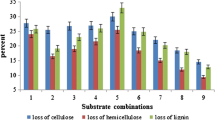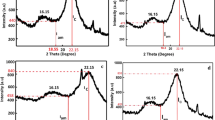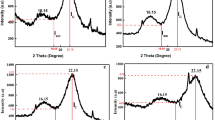Abstract
Cultivation of specialty mushrooms on lignocellulosic wastes represents one of the most economical organic recycling processes. Compared with other cultivated mushrooms, very little is known about the nature of the lignocellulolytic enzymes produced by the edible and medicinal fungus Grifola frondosa, the parameters affecting their production, and enzyme activity profiles during different stages of the developmental cycle. In this work we investigated the enzymes that enable G. frondosa, to colonize and deconstruct two formulations based on industrial lignocellulosic by-products. G. frondosa degraded both substrates (oak-sawdust plus corn bran, and oak/corn bran supplemented with coffee spent-ground) decreasing 67 and 50% of their lignin content, along with 44 and 37% of the polysaccharides (hemicellulose and cellulose) respectively. 35.3% biological efficiency was obtained when using oak sawdust plus corn bran as substrate. Coffee spent-ground addition inhibited mushroom production, decreased growth, xylanase and cellulase activities. However, taking into account that G. frondosa successfully colonized this residue; this substrate formula might be considered for its growth and medicinal polysaccharide production. Although G. frondosa tested positive for Azure B plate degradation, a qualitative assay for lignin-peroxidase, attempts to detect this activity during solid state fermentation were unsuccessful. Enzyme activities peaked during colonization but declined drastically during fruiting body formation. Highest activities achieved were: endoglucanase 12.3, exoglucanase 16.2, β-glucosidase 2.3, endoxylanase 20.3, amylase 0.26, laccase 14.8 and Mn-peroxidase 7.4 U/g dry substrate.


Similar content being viewed by others

References
AOAC (2000) Official method of analysis of AOAC International, 17th edn. AOAC International, Gaithersburg
Archibald FS (1992) A new assay for lignin-type peroxidases employing the dye Azure B. Appl Environ Microbiol 58:3110–3116
Baldrian P (2003) Interactions of heavy metals with white-rot fungi. Enzyme Microb Technol 32:78–91
Baldrian P (2006) Fungal laccases-occurrence and properties. FEMS Microbiol Rev 30:215–242
Bourbonnais R, Paice MG, Reid ID, Lanthier P, Yaguchi M (1995) Lignin oxidation by laccase isozymes from Trametes versicolor and role of the mediator 2, 2-azinobis(3-ethylbenzthiazoline-6-sulfonate) in kraft lignin depolymerization. Appl Environ Microbiol 61:1876–1880
Chen SC, Ma D, Ge W, Buswell JA (2003) Induction of laccase activity in the edible straw mushroom, Volvariella volvacea. FEMS Microbiol Lett 218:143–148
Das N, Sengupta S, Mukherjee M (1997) Importance of laccase in vegetative growth of Pleurotus florida. Appl Environ Microbiol 63:4120–4122
Elisashvili V, Kachlishvili E, Penninckx MJ (2008) Lignocellulolytic enzymes profile during growth and fruiting of Pleurotus ostreatus on wheat straw and tree leaves. Acta Microbiol Immunol Hung 55:157–168
Eriksson KEL, Blanchette RA, Ander P (1990) Microbial and enzymatic degradation of wood and wood components. Springer-Verlag, Berlin
Fan L, Pandey A, Soccol C (1999) Cultivation of Lentinus edodes on the coffee industry residues and fruiting body production. In: Proceedings of the 3rd international conference on mushroom biology and mushroom products, Sidney, October 1999, pp 293–300
Fan L, Pandey A, Mohan R, Soccol CR (2000) Use of various coffee industry residues for the cultivation of Pleurotus ostreatus in solid state fermentation. Acta Biotechnol 20:41–52
Fan L, Pandey A, Soccol C (2001) Production of Flammulina velutipes on coffee husk and coffee spent-ground. Braz Arch Biol Technol 44:205–212
Glenn JK, Gold MH (1985) Purification and characterization of an extracellular Mn(II)-dependent peroxidase from the lignin degrading basidiomycete Phanerochaete chrysosporium. Arch Biochem Biophys 242:329–341
Illana-Esteban C (2008) El hongo maitake (Grifola frondosa) y su potencial terapéutico. Rev Iberoam Micol 25:141–144
Jeffries TW (1990) Biodegradation of lignin-carbohydrate complex. Biodegradation 1:163–176
Job D (2004) Use of coffee spent industry residues for production of Pleurotus ostreatus (Jacq.:Fr.) Kummer in solid state fermentation. Rev Iberoam Micol 21:195–197
Kirk TK, Connors WJ, Zeikus JG (1976) Requirement for a growth substrate during lignin decomposition by two wood-rotting fungi. Appl Environ Microbiol 32:192–194
Kües U, Liu Y (2000) Fruiting body production in basidiomycetes. Appl Microbiol Biotechnol 54:141–152
Lechner BE, Papinutti L (2006) Production of lignocellulosic enzymes during growth and fruiting of the edible fungus Lentinus tigrinus on wheat straw. Process Biochem 41:594–598
Levin L, Papinutti L, Forchiassin F (2004) Evaluation of Argentinean white rot fungi for their ability to produce lignin-modifying enzymes and decolorize industrial dyes. Bioresour Technol 94:169–176
Mata G, Savoie J-M (1998) Extracellular enzyme activities in six Lentinula edodes strains during cultivation in wheat straw. World J Microbiol Biotechnol 14:513–519
Montoya-Barreto S, Varón-López M, Levin L (2008) Effect of culture parameter on the production of the edible mushroom Grifola frondosa (maitake) in tropical weathers. World J Microbiol Biotechnol 24:1361–1366
Nelson NJ (1944) A photometric adaptation of the Somogyi method for the determination of glucose. J Biol Chem 153:375–380
Ohga S, Royse DJ (2001) Transcriptional regulation of laccase and cellulase genes during growth and fruiting of Lentinula edodes on supplemented sawdust. FEMS Microbiol Lett 201:111–115
Orth AB, Royse DJ, Tien M (1993) Ubiquity of lignin-degrading peroxidases among various wood-degrading fungi. Appl Environ Microbiol 59:4017–4023
Pandey A, Soccol CR, Nigam P, Brand D, Mohan R, Roussos S (2000a) Biotechnological potential of coffee pulp and coffee husk bioprocesses. Biochem Eng J 6:153–162
Pandey A, Nigam P, Soccol CR, Soccol VT, Singh D, Mohan R (2000b) Advances in microbial amylases. Biotechnol Appl Biochem 31:135–152
Plassard CS, Mousain DG, Salsac LE (1982) Estimation of mycelial growth of basidiomycetes by means of chitin determination. Phytochemistry 21:345–348
Rühl M, Fischer C, Kües U (2008) Ligninolytic enzyme activities alternate with mushroom production during industrial cultivation of Pleurotus ostreatus on wheat straw-based substrate. Curr Trends Biotechnol Pharm 2:478–492
Salmones D, Mata G, Waliszewski KN (2005) Comparative culturing of Pleurotus spp. on coffee pulp and wheat straw: biomass production and substrate biodegradation. Bioresour Technol 96:537–544
Savoie J-M, Minvielle N, Largeteau M (2008) Radical scavenging properties of extracts from the white button mushroom Agaricus bisporus. J Sci Food Agric 88:970–975
Shen Q, Royse D (2001) Effects of nutrient supplements on biological efficiency, quality and crop cycle time of maitake (Grifola frondosa). Appl Microbiol Biotechnol 57:74–78
Shen Q, Royse D (2002) Effects of genotipes of maitake (Grifola frondosa) on biological efficiency, quality and crop cycle time. Appl Microbiol Biotechnol 58:178–182
Svagelj M, Berovic M, Gregori A, Pahor B, Pohleven F (2007) Production of Grifola frondosa enzymes on solid-state brewery industry wastes. J Biotechnol 131:S240–S241
Tappi Methods (1993) Water solubility of wood and pulp T 207 om-93
Tappi Methods (1998) Acid-insoluble lignin in wood and pulp. T222 om-98
Teller JD (1950) Measurement of amylase activity. J Biol Chem 185:701–704
Thurston CF (1994) The structure and function of fungal laccases. Microbiology 140:19–26
Velázquez-Cedeño MA, Mata G, Savoie JM (2002) Waste reducing cultivation of Pleurotus ostreatus and Pleurotus pulmonarius on coffee pulp: changes in the production of some lignocellulolytic enzymes. World J Microbiol Biotechnol 18:201–207
Wong Y-S, Wang X (1991) Degradation of tannins in spent coffee grounds by Pleurotus sajor-caju. World J Microbiol Biotechnol 7:573–574
Wood T, Bhat K (1988) Methods for measuring cellulose activities. Methods Enzymol 160:87–112
Wood DA, Goodenough PW (1977) Fruiting of Agaricus bisporus: changes in extracellular enzyme activities during growth and fruiting. Arch Microbiol 114:161–165
Xing Z, Cheng J, Tan Q, Pan Y (2006) Effect of nutritional parameters on laccase production by the culinary and medicinal mushroom, Grifola frondosa. World J Microbiol Biotechnol 22:1215–1224
Yin L, Chi Y, Wang X (2010) Phylogenetic analysis and detection of the major ligninolytic enzymes system of Grifola frondosa. For Res. doi:CNKI:SUN:LYKX.0.2010-04-016
Yoshida M, Ohira T, Igarashi K, Nagasawa H, Samejima M (2002) Molecular cloning and characterization of a cDNA encoding cellobiose dehydrogenase from the wood-rotting fungus Grifola frondosa. FEMS Microbiol Lett 217:225–230
Acknowledgments
The authors thank Universidad de Caldas (Colombia), Universidad Nacional Sede Manizales (Colombia), Universidad de Buenos Aires and CONICET (Argentina) for financial assistance.
Author information
Authors and Affiliations
Corresponding author
Rights and permissions
About this article
Cite this article
Montoya, S., Orrego, C.E. & Levin, L. Growth, fruiting and lignocellulolytic enzyme production by the edible mushroom Grifola frondosa (maitake). World J Microbiol Biotechnol 28, 1533–1541 (2012). https://doi.org/10.1007/s11274-011-0957-2
Received:
Accepted:
Published:
Issue Date:
DOI: https://doi.org/10.1007/s11274-011-0957-2



